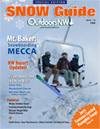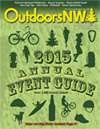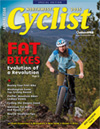Trail Running Gear

The 10 Non-Essential
(but nevertheless good idea) Items List
By Outdoors NW Staff
When it comes to running in general, the beauty of the sport lies in the fact that you need so very little to get started. Even shoes, it seems these days, are optional.
When you step off the pavement and take to the trails, however, the stakes rise. A twisted ankle is not only more likely to happen on a technical, rock- and root-laden trail than it is on city streets, it is also a far more serious problem if it happens in a remote area.
Because trail runs tend to be much longer, and done in more isolated, extreme conditions, the “better safe than sorry” mantra applies. Carrying excess gear weight as a runner is no fun, but it’s still a good rule of thumb to be mindful of the risks you take and pack accordingly.
With that in mind, here’s our list of 10 Non-Essential (but Nevertheless Good Idea) Items for trail runners, in rough order of their essentialism.
#1: A buddy
To help the cougars, bears, and other predators stay away from you, expedite your beeline for the mountains by providing access to the carpool lane, and help out if you fall or injure yourself on a remote trail. If your friends all think you’re crazy, join a group trail run like Seattle Running Club’s Sunday morning runs on Cougar Mountain or Central Oregon Running Klub’s Saturday trail runs in Bend.
#2: Clothing
While more optional on remote trails than around the city, we do recommend wearing clothing. In the Northwest, your best bets are moisture-wicking synthetic or wool layers to help you stay warm and dry; remember the adage “cotton is rotten!” Options like the Salomon EXO IV ¾ Tights or their XR ½ Zip Tech Tee incorporate mild compression elements to stabilize your muscles and increase blood flow.
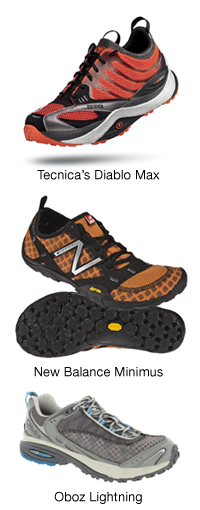 #3: Good shoes
#3: Good shoes
Look for a torsionally stiff shoe — this translates into less work for your foot muscles on rocky, technical trails — and aggressive “lugs,” or traction, on the sole. Some shoes like the popular Brooks Cascadia and Montrail Badrock are heavily cushioned to mimic the feel of a road shoe; Tecnica’s Diablo Max is an oversized trail running shoe with superior downhill performance, and others like the Saucony Peregrine or La Sportiva Crosslite ride low to the ground and tend to be more responsive. Trail Runner magazine Editors recently named the Oboz Lightning its best “true trail runner” saying: “This shoe is begging to be taken over the gnarly stuff.” For the true minimalist devotee looking to be at one with the trails, check out the Vibram Fivefinger Trek, the New Balance Minimus, or the Inov-8 Roclite.
#4: Fuel
You’ll be running longer and more slowly, so expect to eat and drink more overall than when road running. Electrolyte replenishment tabs like Nuun are a great, easy-to-pack option. For food, you can use the same GU energy gels and CLIF Shot Bloks you use for long runs on the road, but consider packing some protein, too, to help keep those muscles humming. We like Justin’s Nut Butter, which comes in squeezable packets and flavors like chocolate hazelnut and honey almond.
#5: Hydration
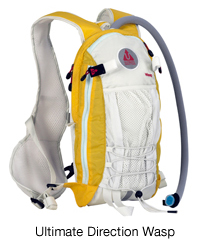 How do you stash that much food in the pockets of your running shorts, you ask? You don’t. You get yourself a handy hydration pack that will strap snugly, with minimal bounce, on your back. Handheld bottles or fanny packs are okay for shorter runs, but if you’ll be out longer than an hour, aim for a pack with a 50 –70 oz. bladder. Popular options like the Nathan HPL 020 Race Hydration Vest (70 oz.) and the Ultimate Direction Wasp (64 oz.), both of which also come in women-specific models, offer many pockets to pack snacks, cell phones, cameras, or items from #10 on this list.
How do you stash that much food in the pockets of your running shorts, you ask? You don’t. You get yourself a handy hydration pack that will strap snugly, with minimal bounce, on your back. Handheld bottles or fanny packs are okay for shorter runs, but if you’ll be out longer than an hour, aim for a pack with a 50 –70 oz. bladder. Popular options like the Nathan HPL 020 Race Hydration Vest (70 oz.) and the Ultimate Direction Wasp (64 oz.), both of which also come in women-specific models, offer many pockets to pack snacks, cell phones, cameras, or items from #10 on this list.
#6: Battery-powered buddies
 While not essential, consider taking a cell phone for safety reasons (though be aware you may not have reception on remote trails). Also consider a watch like the Suunto T3d (upgrade to its GPS Pod accessory) which tracks training effects, real time heart rate, calories burned. The Garmin Forerunner 310xt is a GPS-enabled sport watch and heart rate monitor featuring a high sensitivity GPS that provides improved tracking — even under trees. Of course you need to document the beautiful places you’re going to run — so check out Olympus which makes several excellent compact, waterproof and shockproof cameras.
While not essential, consider taking a cell phone for safety reasons (though be aware you may not have reception on remote trails). Also consider a watch like the Suunto T3d (upgrade to its GPS Pod accessory) which tracks training effects, real time heart rate, calories burned. The Garmin Forerunner 310xt is a GPS-enabled sport watch and heart rate monitor featuring a high sensitivity GPS that provides improved tracking — even under trees. Of course you need to document the beautiful places you’re going to run — so check out Olympus which makes several excellent compact, waterproof and shockproof cameras.
#7: Map
 Because trails aren’t always well-marked, and it’s likely you won’t be hauling emergency shelter in that hydration pack, take a map. Often you can find small, printable maps of trail networks on government websites. For more in depth cartography, check out Green Trails Maps, which feature detailed elevation and mileage data as well.
Because trails aren’t always well-marked, and it’s likely you won’t be hauling emergency shelter in that hydration pack, take a map. Often you can find small, printable maps of trail networks on government websites. For more in depth cartography, check out Green Trails Maps, which feature detailed elevation and mileage data as well.
#8: Gaiters
Small, trail-running-specific gaiters can be a good way to keep dirt, small rocks, pine needles, and mud from sinking through the mesh of your running kicks. We have nothing but raves for Dirty Girl Gaiters, which come in an array of funky designs, and are sold online-only at dirt-cheap prices.
#9: Headlamp
There’s nothing like running up a mountain in the dark and being at the summit for sunrise. Use extra caution when running in the dark, and never run alone. If you do opt to be a nighttime warrior, don a headlamp like the Petzl MYO RXP or the Princeton Tec Quad.
#10: Bonus items for comfort
In the words of Seattle trail runner Alex Henry: “There are no essentials other than Duct tape and Body Glide.” Band-aids® and Vaseline® work well, too. Be sure to lube or tape anywhere that’s vulnerable to chaffing, and get on your merry way.
Happy trails!


